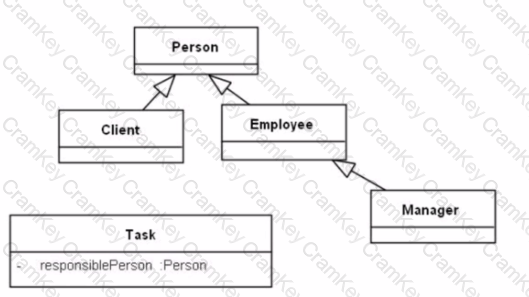Explanation: In UML class diagrams, relationships between classes are represented in a number of different ways, including generalization, association, and composition.
Looking at the provided options, let's analyze each one:
A. responsiblePerson inherits from Person – This is incorrect because theresponsiblePersonis an attribute of theTaskclass, not a class itself, so it cannot inherit fromPerson.
B. Client and Manager have nothing in common – This is incorrect because bothClientandManagerare specialized types ofPersonas indicated by the generalization arrows pointing toPerson.
C. responsiblePerson can not refer to an object of class Client – This is incorrect.responsiblePersonis typed byPerson, which means that it can refer to an instance of any subclass ofPerson, includingClient.
D. The object referred to as responsiblePerson can be a Manager – This is correct. SinceresponsiblePersonis an attribute of theTaskclass with the typePerson, andManageris a subclass ofPerson,responsiblePersoncan indeed refer to an instance ofManager.
The correct answer is based on the UML 2 Foundation specification that describes how attributes are typed by classes and can refer to instances of these classes or their subclasses (UML 2.5 specification, sections 9.3.3 and 9.5.3). The generalization relationship (represented by a triangle followed by a line) establishes a hierarchy between a more general element and a more specific element, which in this case means thatClientandManagerare both specific types ofPersonand can be used whereverPersonis expected (UML 2.5 specification, section 9.4.5).



